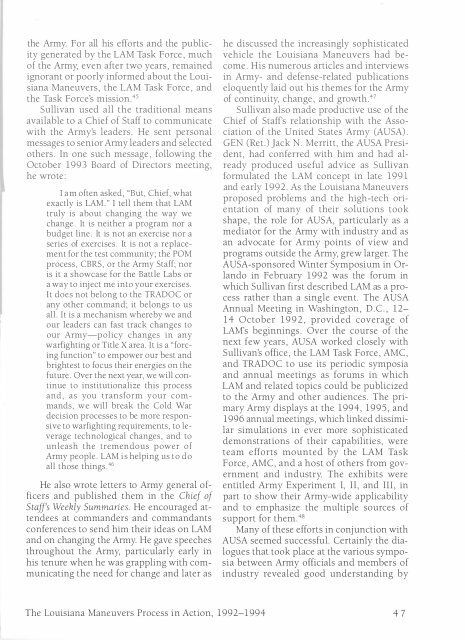The Modern Louisiana Maneuvers - US Army Center Of Military History
The Modern Louisiana Maneuvers - US Army Center Of Military History
The Modern Louisiana Maneuvers - US Army Center Of Military History
You also want an ePaper? Increase the reach of your titles
YUMPU automatically turns print PDFs into web optimized ePapers that Google loves.
the <strong>Army</strong>. For all his efforts and the publicity<br />
generated by the LAM Task Force, much<br />
of the <strong>Army</strong>, even after two years, remained<br />
ignorant or poorly informed about the <strong>Louisiana</strong><br />
<strong>Maneuvers</strong>, the LAM Task Force, and<br />
the Task Force's mission.45<br />
Sullivan used all the traditional means<br />
available to a Chief of Staff to communicate<br />
with the <strong>Army</strong>'s leaders. He sent personal<br />
messages to senior <strong>Army</strong> leaders and selected<br />
others. In one such message, following the<br />
October 1993 Board of Directors meeting,<br />
he wrote:<br />
I am often asked, "But, Chief, what<br />
exactly is LAM ." I tell them that LAM<br />
truly is about changing the way we<br />
change . It is neither a program nor a<br />
budget line . It is not an exercise nor a<br />
series of exercises. It is not a replace<br />
ment for the test community ; the POM<br />
process, CBRS, or the <strong>Army</strong> Staff; nor<br />
is it a showcase for the Battle Labs or<br />
a way to inject me into your exercises.<br />
It does not belong to the TRAD OC or<br />
any other command; it belongs to us<br />
all. It is a mechanism whereby we and<br />
our leaders can fast track changes to<br />
our <strong>Army</strong>-policy changes in any<br />
war fighting or Title X area. It is a "forc<br />
ing function" to empower our best and<br />
brightest to focus their energies on the<br />
future . Over the next year, we will con<br />
tinue to institutionalize this process<br />
and, as you transform your com<br />
mands, we will break the Cold War<br />
decision processes to be more respon<br />
sive to war fighting requirements, to le<br />
verage technological changes, and to<br />
unleash the tremendous power of<br />
<strong>Army</strong> people. LAM is helping us to do<br />
all those things .46<br />
He also wrote letters to <strong>Army</strong> general officers<br />
and published them in the Chief of<br />
Staff's Weekly Summaries. He encouraged attendees<br />
at commanders and commandants<br />
conferences to send him their ideas on LAM<br />
and on changing the <strong>Army</strong>. He gave speeches<br />
throughout the <strong>Army</strong>, particularly early in<br />
his tenure when he was grappling with communicating<br />
the need for change and later as<br />
he discussed the increasingly sophisticated<br />
vehicle the <strong>Louisiana</strong> <strong>Maneuvers</strong> had become.<br />
His numerous articles and interviews<br />
in <strong>Army</strong>- and defense-related publications<br />
eloquently laid out his themes for the <strong>Army</strong><br />
of continuity, change, and growth.47<br />
Sullivan also made productive use of the<br />
Chief of Staff's relationship with the Association<br />
of the United States <strong>Army</strong> (A<strong>US</strong>A) .<br />
GEN (Ret.) Jack N. Merritt, the A<strong>US</strong>A President,<br />
had conferred with him and had already<br />
produced useful advice as Sullivan<br />
formulated the LAM concept in late 1991<br />
and early 1992. As the <strong>Louisiana</strong> <strong>Maneuvers</strong><br />
proposed problems and the high-tech orientation<br />
of many of their solutions took<br />
shape, the role for A<strong>US</strong>A, particularly as a<br />
mediator for the <strong>Army</strong> with industry and as<br />
an advocate for <strong>Army</strong> points of view and<br />
programs outside the <strong>Army</strong>, grew larger. <strong>The</strong><br />
A<strong>US</strong>A-sponsored Winter Symposium in Orlando<br />
in February 1992 was the forum in<br />
which Sullivan first described LAM as a process<br />
rather than a single event. <strong>The</strong> A<strong>US</strong>A<br />
Annual Meeting in Washington, D.C., 12-<br />
14 October 1992, provided coverage of<br />
LAM's beginnings. Over the course of the<br />
next few years, A<strong>US</strong>A worked closely with<br />
Sullivan's office, the LAM Task Force, AMC,<br />
and TRADOC to use its periodic symposia<br />
and annual meetings as forums in which<br />
LAM and related topics could be publiCized<br />
to the <strong>Army</strong> and other audiences. <strong>The</strong> primary<br />
<strong>Army</strong> displays at the 1994, 1995, and<br />
1996 annual meetings, which linked dissimilar<br />
simulations in ever more sophisticated<br />
demonstrations of their capabilities, were<br />
team efforts mounted by the LAM Task<br />
Force, AMC, and a host of others from government<br />
and industry. <strong>The</strong> exhibits were<br />
entitled <strong>Army</strong> Experiment I, II, and Ill, in<br />
part to show their <strong>Army</strong>-wide applicability<br />
and to emphaSize the multiple sources of<br />
support for them.48<br />
Many of these efforts in conjunction with<br />
A<strong>US</strong>A seemed successful. Certainly the dialogues<br />
that took place at the various symposia<br />
between <strong>Army</strong> officials and members of<br />
industry revealed good understanding by<br />
<strong>The</strong> <strong>Louisiana</strong> <strong>Maneuvers</strong> Process in Action, 1992-1994 47
















